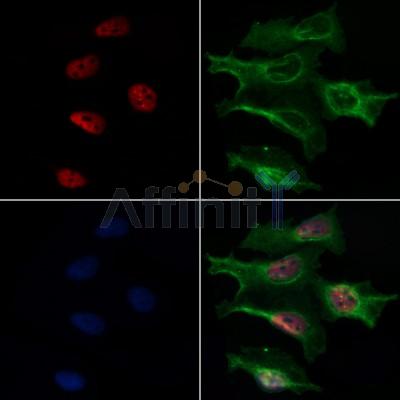ATF7 Antibody - #DF3105
| Product: | ATF7 Antibody |
| Catalog: | DF3105 |
| Description: | Rabbit polyclonal antibody to ATF7 |
| Application: | WB IF/ICC |
| Reactivity: | Human, Mouse, Rat |
| Prediction: | Pig, Bovine, Sheep, Rabbit, Dog |
| Mol.Wt.: | 52 KD; 53kD(Calculated). |
| Uniprot: | P17544 |
| RRID: | AB_2835482 |
Related Downloads
Protocols
Product Info
*The optimal dilutions should be determined by the end user. For optimal experimental results, antibody reuse is not recommended.
*Tips:
WB: For western blot detection of denatured protein samples. IHC: For immunohistochemical detection of paraffin sections (IHC-p) or frozen sections (IHC-f) of tissue samples. IF/ICC: For immunofluorescence detection of cell samples. ELISA(peptide): For ELISA detection of antigenic peptide.
Cite Format: Affinity Biosciences Cat# DF3105, RRID:AB_2835482.
Fold/Unfold
1110012F10Rik; 9430065F09Rik; Activating transcription factor 7; AI549878; ATF7; Atf7 protein; ATF7_HUMAN; ATFA; C130020M04Rik; cAMP-dependent transcription factor ATF-7; Cyclic AMP-dependent transcription factor ATF 7; Cyclic AMP-dependent transcription factor ATF-7; MGC31554; MGC57182; Transcription factor ATF A; Transcription factor ATF-A;
Immunogens
A synthesized peptide derived from human ATF7, corresponding to a region within N-terminal amino acids.
Expressed in heart, lung and skeletal muscle. Isoform 4 is expressed in various tissues including heart, brain, placenta, lung and skeletal muscle. Highest levels in skeletal muscle. Lowest in lung and placenta.
- P17544 ATF7_HUMAN:
- Protein BLAST With
- NCBI/
- ExPASy/
- Uniprot
MGDDRPFVCNAPGCGQRFTNEDHLAVHKHKHEMTLKFGPARTDSVIIADQTPTPTRFLKNCEEVGLFNELASSFEHEFKKAADEDEKKARSRTVAKKLVAAAGPLDMSLPSTPDIKIKEEEPVEVDSSPPDSPASSPCSPPLKEKEVTPKPVLISTPTPTIVRPGSLPLHLGYDPLHPTLPSPTSVITQAPPSNRQMGSPTGSLPLVMHLANGQTMPVLPGPPVQMPSVISLARPVSMVPNIPGIPGPPVNSSGSISPSGHPIPSEAKMRLKATLTHQVSSINGGCGMVVGTASTMVTARPEQSQILIQHPDAPSPAQPQVSPAQPTPSTGGRRRRTVDEDPDERRQRFLERNRAAASRCRQKRKLWVSSLEKKAEELTSQNIQLSNEVTLLRNEVAQLKQLLLAHKDCPVTALQKKTQGYLESPKESSEPTGSPAPVIQHSSATAPSNGLSVRSAAEAVATSVLTQMASQRTELSMPIQSHVIMTPQSQSAGR
Predictions
Score>80(red) has high confidence and is suggested to be used for WB detection. *The prediction model is mainly based on the alignment of immunogen sequences, the results are for reference only, not as the basis of quality assurance.
High(score>80) Medium(80>score>50) Low(score<50) No confidence
Research Backgrounds
Plays important functions in early cell signaling. Binds the cAMP response element (CRE) (consensus: 5'-GTGACGT[AG][AG]-3'), a sequence present in many viral and cellular promoters. Activator of the NF-ELAM1/delta-A site of the E-selectin promoter. Has no intrinsic transcriptional activity, but activates transcription on formation of JUN or FOS heterodimers. Also can bind TRE promoter sequences when heterodimerized with members of the JUN family.
Isoform 4 acts as a dominant repressor of the E-selectin/NF-ELAM1/delta-A promoter.
Isoform 5 acts as a negative regulator, inhibiting both ATF2 and ATF7 transcriptional activities. It may exert these effects by sequestrating in the cytoplasm the Thr-53 phosphorylating kinase, preventing activation.
On EGF stimulation, phosphorylated first on Thr-53 allowing subsequent phosphorylation on Thr-51. This latter phosphorylation prevents sumoylation, increases binding to TAF12 and enhances transcriptional activity.
Sumoylation delays nuclear localization and inhibits transactivation activity through preventing binding to TAF12. RANBP2 appears to be the specific E3 ligase.
Nucleus. Nucleus>Nucleoplasm.
Note: Mainly nucleoplasmic. Restricted distribution to the perinuculear region. The sumoylated form locates to the nuclear periphery.
Cytoplasm.
Expressed in heart, lung and skeletal muscle. Isoform 4 is expressed in various tissues including heart, brain, placenta, lung and skeletal muscle. Highest levels in skeletal muscle. Lowest in lung and placenta.
Belongs to the bZIP family.
Restrictive clause
Affinity Biosciences tests all products strictly. Citations are provided as a resource for additional applications that have not been validated by Affinity Biosciences. Please choose the appropriate format for each application and consult Materials and Methods sections for additional details about the use of any product in these publications.
For Research Use Only.
Not for use in diagnostic or therapeutic procedures. Not for resale. Not for distribution without written consent. Affinity Biosciences will not be held responsible for patent infringement or other violations that may occur with the use of our products. Affinity Biosciences, Affinity Biosciences Logo and all other trademarks are the property of Affinity Biosciences LTD.




